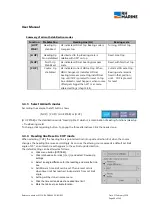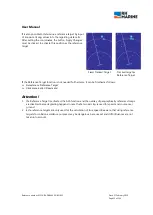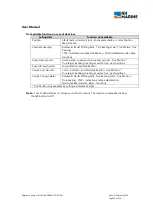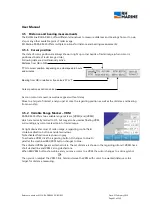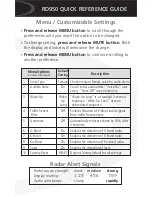
User Manual
Reference number: 4111A-RADAR4600-GBD-R1.1
Date: 27 February 2018
Page 53 of 149
Menu < Own Ship Past Track >
To activate ‘Own Ship Past Track’, click menu button [SYSTEM].
Select menu ‘Own Ship Past Track’ and click the box beside of ‘SHOW OS
PAST POSN’ to set a tick.
Then you can select following functions:
Line:
A white line is shown, backwards of OS, indicating the past track within a
time, which is set with the TRAILTIME selector.
Time Increments (interval adjusted):
The backwards directed line will be shown, with the length regarding to
set ‘TRAILTIME’, separated by tick marks according to a preselected time
interval.
Following ‘Past Track Interval’ can be set: 0.15/0,30/0,45/1/2/5/10 and 30
minutes.
Past Positions (interval adjusted):
Same indication than before, but in case of time marks, position marks
will be set in the selectable time interval, with small points.
Past Positions (speed adjusted):
Same indication than before, but now the position marks are set in
accordance to ships speed.
Length and Mode of setting
Select sub menu ‘Settings’ and set the length of drawing OS Past Track.
At last, select the recording length for OS Past Track.
Mode selection and Start of a new recording
Click [PAST POSN], select the recording mode, True (T PAST POSN) or Relative (R PAST
POSN).
To delete actual recording and start new recording, click [RESET].
Attention!
Selection of motion mode 'True' or 'Relative' is not only limited for past
position indication. It is a system wide order and changes the total
operation mode between True and Relative mode (same function as the
selector button (TM)/(RM) upside right of display).
Example with Past Track line
and position points
Important notes about Past Track recording!
A)
Past track recording will not be saved at switching off the system. Maximum length of Past Tracks
cannot be longer than the length of the actual system operating time.
B)
The system cannot produce Past Tracks for Sleeping AIS targets.
C)
The past track information for activated AIS targets are continuously controlled, saved and can be called
up any time. Information about the tracks of radar targets are saved only for the time, the tracks are
shown in radar image.
3.4.15
COG/SOG degradations at slow speed conditions
If Ground Stabilisation is calculated by GPS values, minor alterations of speed and course values may be
noticed when OS has stopped or moves with very slow speed. This is based on the HDOP (Horizontal






